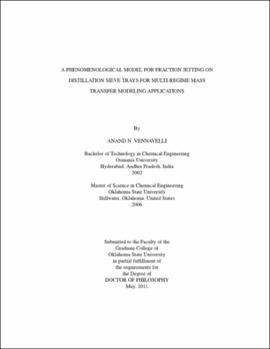| dc.contributor.advisor | Whiteley, James R. | |
| dc.contributor.author | Vennavelli, Anand N. | |
| dc.date.accessioned | 2013-11-26T08:31:43Z | |
| dc.date.available | 2013-11-26T08:31:43Z | |
| dc.date.issued | 2011-05 | |
| dc.identifier.uri | https://hdl.handle.net/11244/7173 | |
| dc.description.abstract | Scope and Method of Study: Predicting the fraction of the vapor transported as jets, or fraction jetting, on a distillation tray operating in the mixed-froth regime has several advantages. The fraction jetting model can explain the gradual changes in tray efficiency during the froth-spray transition and eliminate the need to predict the frothspray transition point when separate froth and spray regime models are used. Fraction jetting models facilitate multi-regime efficiency models, such as the Syeda, Afacan, and Chuang (2007) sieve tray efficiency model, that are valid for both froth and spray regimes. In this work, a new phenomenological model to predict fraction jetting is presented. The model is developed using the air-water fraction jetting data of Raper et al. (1982) on sieve trays. The fraction jetting model is developed such that it can be directly used in multi-regime mass transfer modeling applications. | |
| dc.description.abstract | Findings and Conclusions: A single parameter phenomenological model, based on the modified Froude number, has been developed. The model structure is consistent with existing empirical fraction jetting models and the model parameter signifies a change in the dominant mode of vapor transport from bubbles to jets. In addition, the model predictions of the Syeda et al. sieve tray efficiency model with (a) the new fraction jetting model and (b) the Syeda et al. fraction jetting model are compared to show that the new fraction jetting model can directly replace the Syeda et al. fraction jetting model in the Syeda et al. sieve tray efficiency model while retaining the unique crowned efficiency-rate patterns of the Syeda et al. efficiency model. The new fraction jetting model is expected to lead to improved models for predicting multi-regime efficiency as it is based on a phenomenological understanding of the mechanisms that lead to bubbling and jetting. | |
| dc.format | application/pdf | |
| dc.language | en_US | |
| dc.rights | Copyright is held by the author who has granted the Oklahoma State University Library the non-exclusive right to share this material in its institutional repository. Contact Digital Library Services at lib-dls@okstate.edu or 405-744-9161 for the permission policy on the use, reproduction or distribution of this material. | |
| dc.title | Phenomenological model for fraction jetting on distillation sieve trays for multi-regime mass transfer modeling applications | |
| dc.contributor.committeeMember | Wagner, Jan | |
| dc.contributor.committeeMember | High, Karen A. | |
| dc.contributor.committeeMember | Shariat, Ahmad | |
| dc.contributor.committeeMember | Lilley, David G. | |
| osu.filename | Vennavelli_okstate_0664D_11315.pdf | |
| osu.accesstype | Open Access | |
| dc.type.genre | Dissertation | |
| dc.type.material | Text | |
| dc.subject.keywords | distillation | |
| dc.subject.keywords | efficiency | |
| dc.subject.keywords | flow regime | |
| dc.subject.keywords | jetting | |
| dc.subject.keywords | sieve trays | |
| thesis.degree.discipline | Chemical Engineering | |
| thesis.degree.grantor | Oklahoma State University | |
